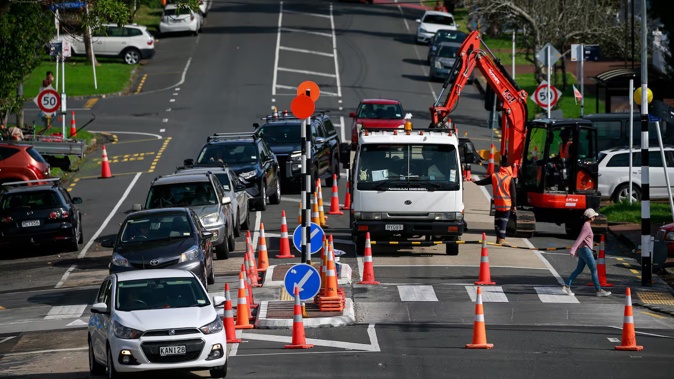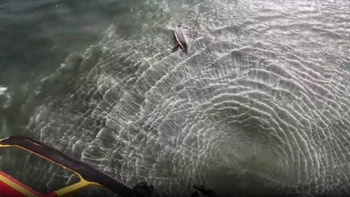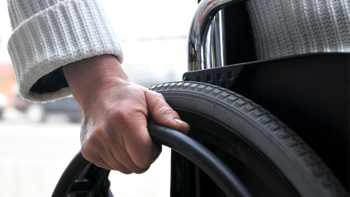
An Auckland Transport manager has put in a plea for less red tape around costly traffic management rules, saying in other countries there was an onus on drivers to be careful around roadworks rather than a “sea of red cones”.
Mark Banfield, Auckland Transport’s (AT) general manager of infrastructure project delivery, was speaking to the transport select committee about the cost of traffic management around roadworks. It was part of a briefing on the $490,000 overall cost of the Williamson Avenue raised pedestrian crossing in Grey Lynn. Of that, about $142,000 was on traffic management alone.
Banfield said he was not happy about that cost, saying it was “burdensome” on both the public and AT’s coffers.
AT had come under pressure for the cost of installing pedestrian crossings and other roading projects, and Banfield said it was working to bring that down as well as trying to reduce the amount of time traffic was disrupted.
Asked what could be done to reduce the cost without impacting on safety, Banfield said less red tape would be helpful and pointed to NZ Transport Agency Waka Kotahi’s (NZTA) recent review of temporary traffic rules to take a site-specific approach based on risk rather than using the same measures for every project.
“Just keep moving in that direction would be my feedback on that.”
He said in countries such as the United Kingdom, roading projects did not involve “this sea of red cones”.
“It’s because there’s a huge onus and obligation on drivers to be careful around road workers. Whereas here, we seem to have a situation where we almost set up our sites as if everybody is drunk and under the influence of drugs and alcohol on the roads and we have to stop them being killed.”
Teresa Burnett, AT’s general manager of transport safety, also agreed with National MP Grant McCallum’s suggestion that stiffer penalties for speeding through temporary speed limit areas would be helpful.
Banfield also pointed to the difficulties in getting skilled workers, saying there were “managers for Africa” but they were no use when it came to pouring concrete to a certain specification.
“That’s a broad industry issue. Some examples are concrete work, drain layers are a dying breed, gas fitters. Trying to get good people on the ground in these areas. And grader drivers. What used to happen in New Zealand is a grader driver would be a grumpy old grader driver who was the boss on a site, and he would train up a couple of young people underneath him and develop that skill. It’s not sexy enough now. Nobody wants to be a grader driver. So you start losing that.”
Banfield said steps were being taken to try to bring down the cost of traffic management which had resulted in the cost dropping from an average of about 18 per cent of a project to 11 per cent.
Traffic management costs on major roading projects was around 10 per cent of the total cost, but on pedestrian crossings such as on Williamson, it had been 25-35 per cent.
For the Eastern Busway, it was only at about 5 per cent. “So it’s starkly different.”
Banfield said other steps taken included using temporary lane re-configurations instead of stop-go operators “for endless days on end”.
There were also efforts to shorten the length of time a project took, such as the use of pre-cast concrete units for the raised tables at a crossing in Kumeū.
He said that allowed the basic crossing infrastructure to be installed in one shift - meaning traffic management was only needed for one night at a cost of about $3000 compared to the $142,000 cost of Williamson Ave.
“We are looking at how we can get away with more efficient methodologies, re-designing the project scope, looking to bundle and coordinate works and revising the contractual risk ownership of temporary traffic management costs.”
He said often Auckland Transport carried the risk of blowouts in the cost of traffic management and it was looking at moving to a lump-sum approach and transferring the delivery risk to the contractor carrying it out. He said that was what was done on larger projects, and gave AT more cost certainty.
Burnett said the upgrade of the Williamson Ave crossing, and others, were the response to a report showing 20 per cent of pedestrian accidents in Auckland had happened at zebra crossings. About half of serious death and injuries in Auckland were people outside vehicles, such as on bikes or pedestrians - the social cost of that was estimated at $2 billion.
The Williamson Ave crossing itself was $33,000 while the rest was in associated work, such as traffic management, substantial storm water upgrades, new street lighting, bus stop upgrades, signage, road markings and signs.
Claire Trevett is the NZ Herald’s political editor, based at Parliament in Wellington. She started at the Herald in 2003 and joined the Press Gallery team in 2007. She is a life member of the Parliamentary Press Gallery.
This article was originally published on the NZ Herald here.
Take your Radio, Podcasts and Music with you









